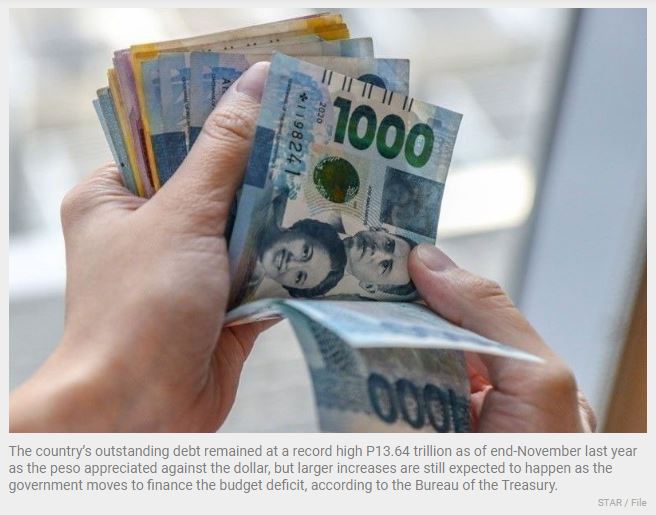Philippine debt barely moves in November
MANILA, Philippines — The country’s outstanding debt remained at a record high P13.64 trillion as of end-November last year as the peso appreciated against the dollar, but larger increases are still expected to happen as the government moves to finance the budget deficit, according to the Bureau of the Treasury.
The latest figure was only 0.02 percent or P3.15 billion higher than the end-October 2022 level, primarily due to the effect of local currency appreciation against the dollar on foreign currency loans.
The peso appreciated by 2.5 percent in November last year, ending the month at 56.598 to $1 compared to the 58.047 to $1 level in end-October.
This effectively reduced the peso equivalent of the country’s foreign debts. This was also coupled with the lack of new debt issuances as the government just came from a $2-billion global bond issuance the month before.
On a yearly basis, however, the debt pile jumped by 14.35 percent from P11.93 trillion in November 2021.
For the five months in office of the Marcos administration, it has so far added P852.3 billion in obligations. Likewise, the current debt stock is already 1.56 percent above the P13.43 trillion expected debt pile by the end of 2022.
Despite the minimal increase in November, Rizal Commercial Banking Corp. chief economist Michael Ricafort said the outstanding debt could still post new record highs in the coming months.
“This is amid plans to issue new dollar-denominated bonds as well as dollar-denominated retail bonds in the first quarter worth about $3 trillion with a tenor of at least five years,” Ricafort said.
“This is on top of the scheduled issuances of peso-denominated government securities and possible new Retail Treasury Bond issuance, all of which will help finance the country’s budget deficit for the coming months this year,” he said.
Leonardo Lanzona, economist and professor at the Ateneo de Manila University, on the other hand, does not expect the debt to rise any further.
“I don’t think the economic managers are confident that the economy can outgrow the debt, which is the essential condition for acquiring more loans,” Lanzona said in a Viber message.
“I think the government will try to work out its tax revenue collection in an attempt to push its programs and accumulate as much funds as possible,” he said.
In particular, Lanzona argued that much of the funds are expected to come from the proposed Maharlika Investment Fund (MIF).
But given the issues surrounding the MIF, Lanzona said it would be better to just raise the debt further and at the same time strengthen institutions to eliminate corruption.
“The goal then is to use whatever debt we can manage, but ensure that the programs coming out of these funds are productive enough to offset the debts,” he said.
Meanwhile, the Treasury said domestic borrowing accounted for the majority or 69 percent of the debt pile. The rest or 31 percent of the country’s borrowing came from external sources.
Total domestic debt at P9.43 trillion slightly inched up by 0.78 percent on a monthly basis, but jumped 11.7 percent from the P8.44 trillion year-on-year.
The increase was attributed to the net issuance of P75.76 billion in government securities while local currency appreciation against the dollar trimmed P3.13 billion from the debt stock.
Domestic debt has already increased by 15.4 percent to P1.26 trillion since the start of 2022 due to continued preference for domestic financing to mitigate the effects of currency fluctuations.
External obligations, on the other hand, decreased by 1.62 percent to P4.22 trillion month-on-month, but surged 21 percent from the P3.49 trillion in the same period in 2021.
The Treasury said the lower external debt was due to the P106.98 billion impact of local currency appreciation and P13.38 billion net repayment.
This was tempered by the net impact of third-currency fluctuations against the dollar amounting to P50.78 billion.
Meanwhile, total debt guaranteed obligations inched up by 0.38 percent to P388 billion due to the net availment of domestic guarantees amounting to P1.03 billion and the net effect of currency fluctuations that increased the value of external guarantees by P440 million.
Source: https://www.philstar.com/business/2023/01/04/2235100/philippine-debt-barely-moves-november


 Thailand
Thailand




